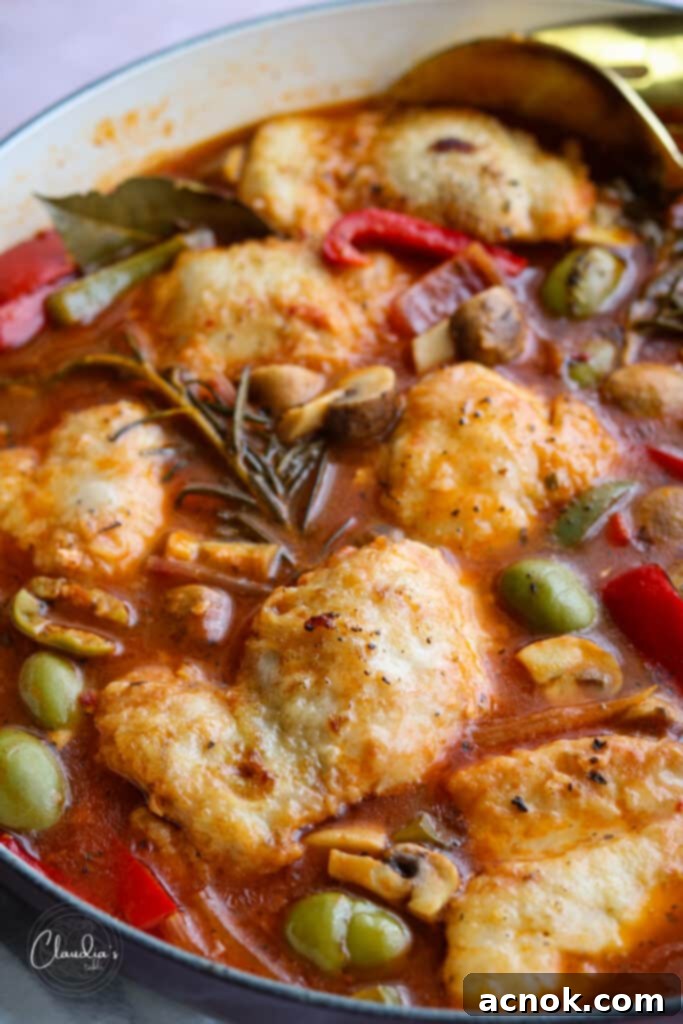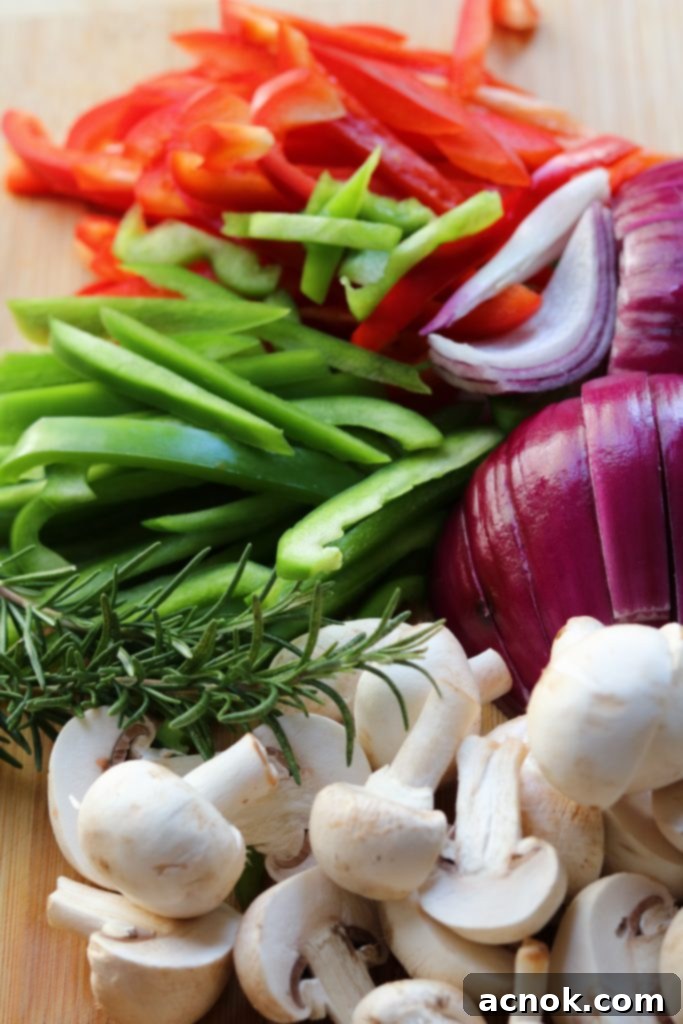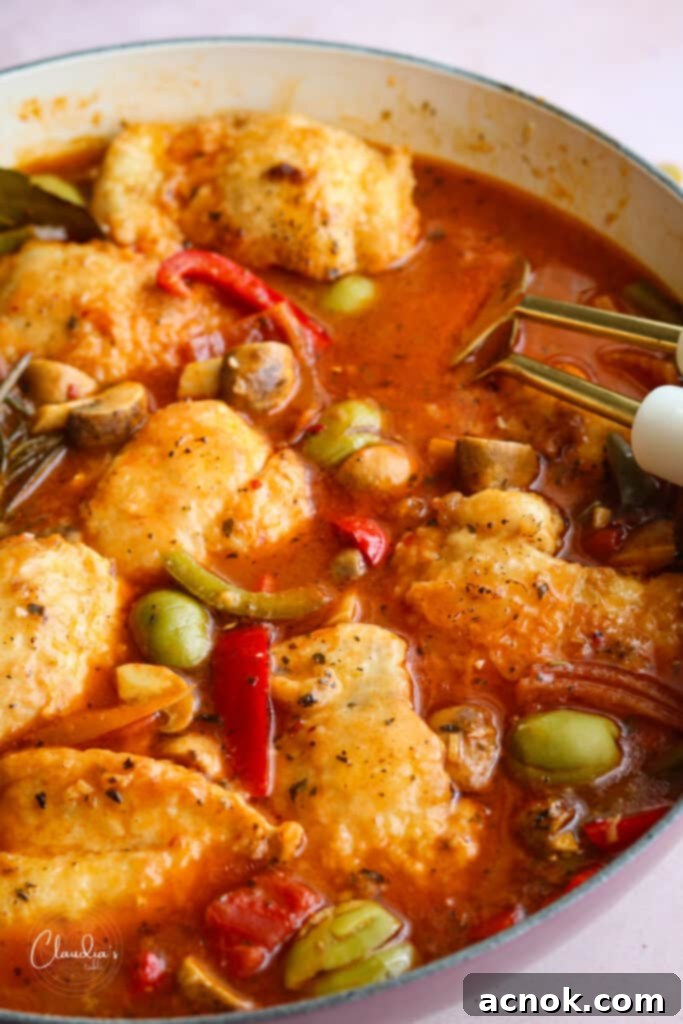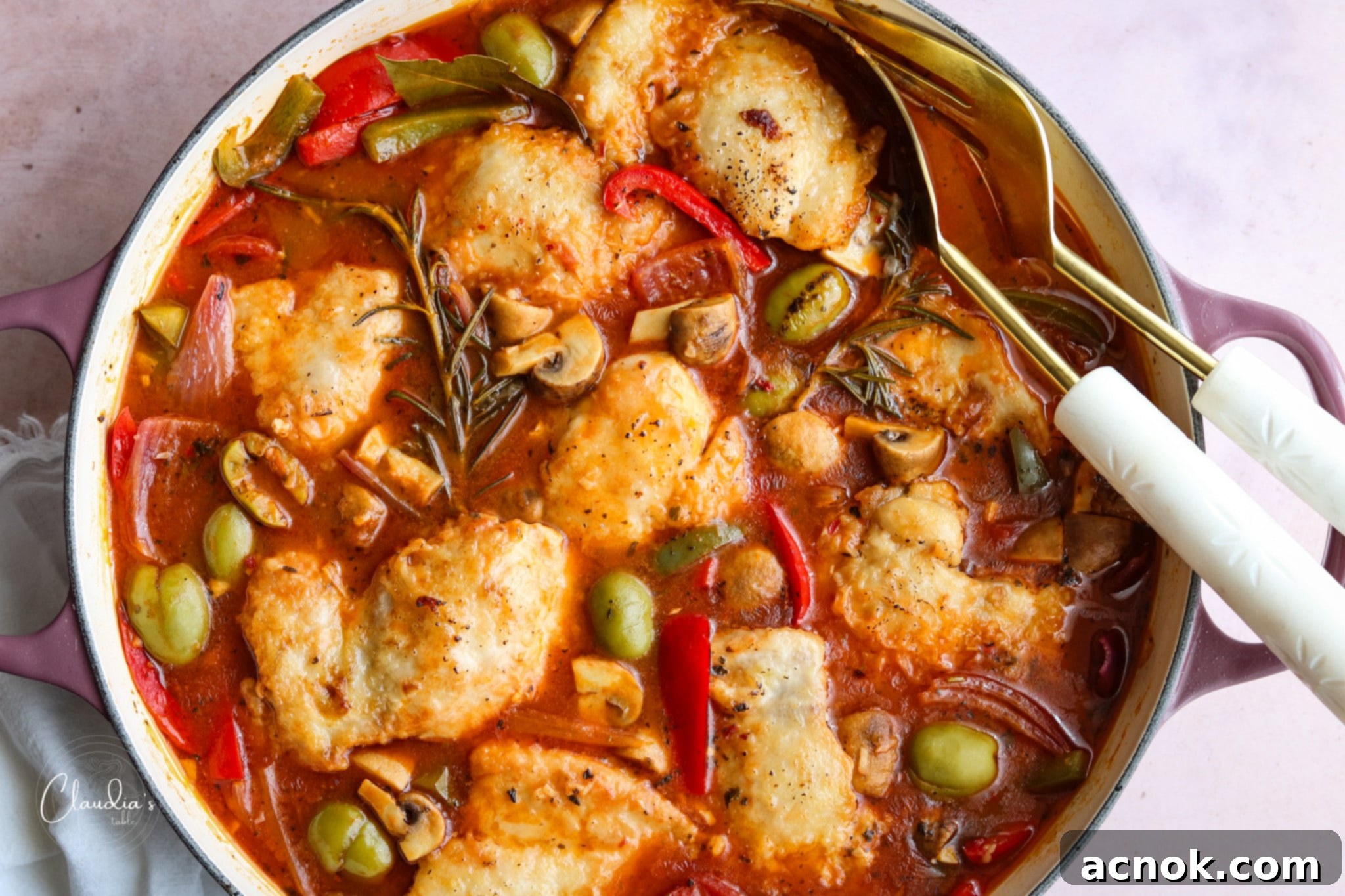Easy Boneless Chicken Cacciatore: A Wholesome & Flavorful Italian Weeknight Meal
This Easy Boneless Chicken Cacciatore recipe is a comforting and hearty dish, perfectly suited for cooler evenings or any time you crave a delicious, home-cooked meal. While inspired by the classic Italian Cacciatore, this version offers a modern, simplified take that’s heavy on tender vegetables and features a lighter, yet incredibly flavorful, tomato-based sauce. By using boneless, skinless chicken thighs and breasts, we’ve made this beloved dish easier to prepare and more appealing for even the pickiest eaters in your family. Our unique approach incorporates dry white wine and chicken broth, creating a thinner, highly aromatic sauce that truly highlights the fresh ingredients and cooks quickly.
Beyond being a fantastic family dinner, this Boneless Chicken Cacciatore is also an excellent choice for entertaining guests. Imagine starting with a beautiful Antipasto Platter, followed by a crisp green salad, and finishing with this rich, satisfying cacciatore. It’s a guaranteed crowd-pleaser that delivers authentic Italian-inspired flavors without the fuss. Get ready to add this versatile and delightful recipe to your regular rotation, bringing a taste of Italy straight to your kitchen!

Table of Contents
- Chicken Cacciatore: Traditional vs. Modern Origins
- Why Choose Boneless Chicken Cacciatore?
- Key Ingredients for Our Easy Boneless Chicken Cacciatore
- Vegetable Prep Made Easy
- Stovetop Method: Detailed Steps
- Slow Cooker Method for Convenient Chicken Cacciatore
- Tips for a Perfect Chicken Cacciatore
- What to Serve with Chicken Cacciatore: Pairing Suggestions
- How to Store and Reheat Leftovers
Chicken Cacciatore: Traditional vs. Modern Origins
The name Cacciatore, translating to “hunter” in Italian, gives us a glimpse into the rustic origins of this beloved dish. Traditionally, Chicken Cacciatore (or sometimes rabbit cacciatore) was a hearty meal prepared by hunters using ingredients they could forage or find easily – typically meat, onions, herbs, and local vegetables. Authentic Italian cacciatore often features bone-in, skin-on chicken, which provides an intense depth of flavor as it slow-cooks. Recipes can vary widely across Italy’s regions, with some incorporating more robust red wines and a richer, thicker tomato base, while others might include a wider array of vegetables and different herb profiles, making each regional cacciatore unique.
Our Easy Boneless Chicken Cacciatore, however, presents a delightful modern interpretation. We’ve opted for skinless, boneless chicken thighs and breasts, making the dish quicker to cook, easier to eat, and appealing to a broader audience, especially families with children who prefer not to deal with bones. While traditional recipes often lean on red wine for depth, our version utilizes a dry white wine, which contributes a lighter, more aromatic quality to the sauce, enhancing the freshness of the vegetables. Furthermore, we embrace a generous amount of colorful bell peppers, tender mushrooms, and sweet onions, transforming the dish into a more wholesome and vibrant meal. This adaptation retains the comforting essence of a classic cacciatore while streamlining the process for today’s busy kitchens, offering a fresh perspective on Italian comfort food.
Why Choose Boneless Chicken Cacciatore?
Choosing boneless, skinless chicken for Cacciatore is a deliberate decision that offers several advantages, aligning with our goal of an “easy” and “modern” recipe. Firstly, it significantly reduces cooking time. Without bones, the chicken cooks more evenly and quickly, making it an ideal choice for busy weeknight dinners when time is of the essence. Secondly, boneless chicken eliminates the need to navigate around bones while eating, which is a major plus for families with picky eaters or for a more refined dining experience when hosting guests. It also makes for easier serving and meal prep. Thirdly, while bone-in chicken offers more flavor from the bone marrow, our recipe compensates for this by building a rich, layered flavor profile through proper browning, deglazing the pan, and a thoughtful combination of herbs and aromatics in the sauce. This approach ensures that you get all the comforting, deep flavors of cacciatore with added convenience and a slightly lighter feel, without sacrificing any of the delicious taste.

Key Ingredients for Our Easy Boneless Chicken Cacciatore
The beauty of this boneless chicken cacciatore lies in its simple yet robust ingredient list, carefully chosen to deliver maximum flavor and comfort. Each component plays a vital role in creating a balanced and delicious dish:
- 3 pounds chicken, skinless, boneless: A versatile mix of thighs and breasts (breasts cut in half for even cooking) ensures varied texture and a rich flavor. Thighs stay particularly juicy during braising.
- 1/2 cup all-purpose flour: Used for lightly dredging the chicken, which helps create a beautiful golden crust when seared and slightly thickens the sauce during the braising process, adding body.
- 3 tablespoons extra virgin olive oil: The essential foundation for sautéing and browning, infusing the dish with its characteristic rich, Mediterranean flavor. Choose a good quality oil for the best results.
- 1 whole red bell pepper, cored and sliced: Adds natural sweetness and a vibrant pop of color, mellowing beautifully as it cooks down.
- 1 whole green bell pepper, cored and sliced: Contributes a slightly more robust, earthy flavor that balances the sweetness of the red pepper, essential for the cacciatore’s vegetable base.
- 1/2 whole red onion, sliced: Offers a milder, sweeter onion flavor than yellow onions, and its beautiful purple hue adds to the dish’s visual appeal. Sliced into 8 wedges, it retains texture.
- 8 ounces mushrooms, whole (white, cremini, baby Bellas): Halved or quartered depending on size. Mushrooms are crucial for adding an umami depth and a satisfying, meaty texture to the sauce.
- 4 cloves garlic, roughly chopped: The aromatic cornerstone of countless Italian dishes, boosting the overall savory and pungent flavor of the cacciatore.
- 1 cup dry white wine: Such as Pinot Grigio, Sauvignon Blanc, or a dry Vermentino. This deglazes the pan, adding a bright, acidic lift and complex notes to the sauce without overpowering it.
- 1 cup chicken stock/broth: Forms the primary liquid base of the sauce, adding essential savory depth and ensuring the chicken stays moist and tender as it braises.
- 1 can diced tomatoes, 14.5 oz, with their juice: Italian-style diced tomatoes are highly recommended for their superior flavor, vibrant color, and consistent quality, providing the core of the cacciatore’s sauce.
- 1 tablespoon concentrated tomato paste: A small but mighty ingredient that deepens the tomato flavor and adds a rich, concentrated sweetness to the sauce, giving it more complexity.
- 1 cup olives, whole, green or black, pitted and unstuffed: Castrelvano olives are a preferred choice for their buttery, mild flavor, but Kalamata or other green/black olives work well too. They introduce a briny, salty, and distinctly Mediterranean element.
- 1 teaspoon dry Italian seasoning: A convenient blend of classic Italian herbs like oregano, basil, thyme, and rosemary, providing a foundational herbaceous flavor.
- 1 teaspoon dry basil: Further enhances the herbaceous, slightly sweet, and aromatic notes of the tomato sauce.
- 1/2 teaspoon red pepper flakes: For a subtle warmth and a gentle kick; adjust to your preferred spice level for more or less heat.
- 2 sprigs fresh rosemary: Adds a beautiful, fragrant piney note that pairs wonderfully with chicken and the other Mediterranean flavors. Fresh herbs always elevate a dish.
- 1 whole bay leaf, dry: Infuses the sauce with a subtle, aromatic complexity that deepens over the long cooking process.
- 2 teaspoons kosher salt, divided: Essential for enhancing all the flavors. 1 teaspoon is used for seasoning the chicken, and the remaining 1 teaspoon for the sauce.
- 1 teaspoon black pepper: Adds a gentle heat and balances the overall seasoning, providing a well-rounded taste.
Vegetable Prep Made Easy
Efficient vegetable preparation (often called “mise en place”) is key to making this recipe truly easy and enjoyable, especially on busy weeknights. While the list below provides guidelines, don’t hesitate to purchase pre-sliced vegetables from your grocery store to save time. I find it most efficient to chop the vegetables while the chicken is browning; by the time the chicken is golden, your vegetables will likely be ready to go into the pan. This parallel workflow significantly reduces active cooking time and makes the entire process smoother.
- Bell peppers: Wash thoroughly, remove seeds and the white inner membrane, then cut into uniform strips or chunks. Consistency in size helps them cook evenly.
- Mushrooms: Wipe clean with a damp cloth (avoid rinsing to prevent sogginess). Halve or quarter them, depending on their size. Larger pieces will hold their texture better during braising and contribute more body to the dish.
- Onion: Peel and cut into 8 distinct wedges. This cut helps the onion maintain some bite and visual appeal after simmering, rather than dissolving completely into the sauce.
- Garlic: Peel and roughly chop. No need for a fine mince here; rustic pieces contribute more intense garlic flavor to the braise as they slowly release their aromatics.
- Olives: Ensure they are pitted. You can leave them whole or halve them, depending on your preference. Castrelvano olives are particularly recommended for their mild, buttery profile that complements the dish without overpowering it, adding a delightful briny burst.

Stovetop Method: Detailed Steps
Creating this delicious Boneless Chicken Cacciatore on the stovetop is a straightforward process, resulting in a deeply flavorful and tender meal that cooks efficiently. Follow these detailed steps for a perfect cacciatore every time:
- Step 1: Prepare Your Vegetables. Begin by ensuring all your vegetables are prepped. Core and slice the bell peppers. Slice the red onion into wedges. Clean and either halve or quarter your mushrooms. Finally, peel and roughly chop the garlic cloves. Have all your prepped vegetables set aside in separate bowls, ready for quick addition to the pan.
- Step 2: Season and Dredge the Chicken. Using paper towels, thoroughly pat the boneless chicken pieces (thighs and halved breasts) dry. This critical step ensures proper searing. Season both sides generously with 1 teaspoon of kosher salt and 1/2 teaspoon of black pepper. Lightly dredge each chicken piece in the all-purpose flour, making sure to gently shake off any excess. This light coating helps create a beautiful golden-brown crust and contributes to thickening the sauce later.
- Step 3: Brown the Chicken. Place a large 5-7 quart braiser or Dutch oven with a lid over medium-high heat. Add 2 tablespoons of olive oil and heat until it’s shimmering and just starting to smoke lightly. Carefully add the floured chicken pieces to the hot oil in a single layer, ensuring not to overcrowd the pan. You will likely need to do this in two batches to allow the chicken to brown properly. Brown each side until deeply golden, about 3-4 minutes per side. The chicken does not need to be fully cooked through at this stage; it will finish cooking during the braising process. Remove the browned chicken and set it aside on a clean plate.
- Step 4: Sauté the Aromatics and Vegetables. Using the same pan (and adding the remaining 1 tablespoon of olive oil if needed), add your prepared bell peppers, red onion, mushrooms, and chopped garlic. Sauté for about 5-7 minutes, stirring frequently, until the vegetables start to soften and turn bright in color. The fond (browned bits) left from the chicken at the bottom of the pan will infuse the vegetables with incredible flavor.
- Step 5: Deglaze with White Wine. Pour in the dry white wine and immediately scrape the bottom of the pan vigorously with a wooden spoon or spatula to deglaze. This action lifts all the flavorful browned bits from the chicken and vegetables into the liquid, forming the foundation of your rich sauce. Let the wine simmer for about 1-2 minutes to reduce slightly and allow some of the alcohol to cook off, leaving behind its wonderful aroma.
- Step 6: Build the Sauce. Stir in the chicken broth, the entire can of diced tomatoes with their juice, concentrated tomato paste, and the pitted olives. Add the Italian seasoning, dried basil, bay leaf, fresh rosemary sprigs, red pepper flakes, and the remaining 1 teaspoon of kosher salt, and 1/2 teaspoon of black pepper. Stir well to combine all the ingredients thoroughly, ensuring the tomato paste is fully dissolved. Bring the mixture to a gentle simmer.
- Step 7: Braise the Chicken. Gently nestle the browned chicken pieces back into the pan, ensuring they are partially submerged in the flavorful vegetable and broth mixture. Arrange them evenly so they can cook uniformly.
- Step 8: Simmer to Perfection. Place the lid securely on the braiser or Dutch oven and reduce the heat to low. Allow the cacciatore to simmer gently for 30-35 minutes. This slow braising process tenderizes the chicken to perfection and allows all the diverse flavors to meld beautifully, creating a complex and harmonious sauce.
- Step 9: Check for Doneness and Serve. After 30-35 minutes, check the chicken to ensure it’s cooked through (an internal temperature of 165°F or 74°C). The vegetables should be tender. Taste the sauce and adjust seasoning if necessary, adding more salt, pepper, or red pepper flakes to your preference. Serve your Easy Boneless Chicken Cacciatore hot, with your favorite side dish and plenty of warm, crusty bread for soaking up every last drop of the delicious sauce.
Slow Cooker Method for Convenient Chicken Cacciatore
For those days when you need a more hands-off approach, this Boneless Chicken Cacciatore adapts beautifully to a slow cooker. The slow cooker will ensure ultra-tender chicken and a rich, deeply flavored sauce with minimal effort. While it adds a small initial step, I highly recommend browning the chicken before adding it to the slow cooker for an unparalleled depth of flavor. This step is crucial for developing the complex savory notes that truly make cacciatore shine. A 6-8 quart slow cooker is ideal for this recipe to comfortably accommodate all ingredients.
- Step 1: Prepare and Brown the Chicken. Pat the boneless chicken pieces dry with paper towels and season generously with 1 teaspoon of kosher salt and 1/2 teaspoon black pepper on both sides. In a large 5-quart braiser, Dutch oven, or a large skillet, add 2 tablespoons of olive oil and heat over medium-high until hot. Lightly dredge the chicken in flour and brown each piece until golden on both sides (about 3-4 minutes per side). This step creates a crucial flavor layer. You don’t need to cook the chicken all the way through; just get a good, deep sear. Remove the browned chicken and set aside.
- Step 2: Sauté Aromatics (Optional but Recommended). In the same pan, add the remaining 1 tablespoon of olive oil (if needed) and sauté the chopped bell peppers, red onion, mushrooms, and garlic for 5-7 minutes until softened. This step further develops flavor before transferring to the slow cooker. Deglaze the pan with the white wine, scraping up any browned bits, and simmer for 1 minute.
- Step 3: Assemble in the Slow Cooker. Transfer the sautéed vegetables and wine mixture (if performed) to the crock of your 6-8 quart slow cooker. If skipping sautéing, add the raw, sliced vegetables, garlic, and white wine directly to the slow cooker. Add the chicken broth, diced tomatoes with their juice, concentrated tomato paste, olives, Italian seasoning, dried basil, bay leaf, fresh rosemary, and red pepper flakes. Stir all these ingredients together until well combined.
- Step 4: Add Chicken and Cook. Gently nestle the browned chicken pieces into the vegetable and sauce mixture in the slow cooker. Ensure the chicken is partially covered by the liquid.
- Step 5: Set and Forget. Place the lid securely on the slow cooker and cook on the LOW setting for 6-8 hours, or on HIGH for 3-4 hours, until the chicken is incredibly tender and cooked through, and the vegetables are soft. The slow cooker will do all the work, developing deep, rich flavors while you go about your day.
- Step 6: Serve. Once cooked, stir gently, remove bay leaf and rosemary sprigs, taste, and adjust seasoning if needed. Serve hot with your desired accompaniments.
Tips for a Perfect Chicken Cacciatore
Achieving a restaurant-quality Boneless Chicken Cacciatore at home is easy with a few key techniques and considerations. These tips will help ensure your dish is always a success, bursting with flavor and perfectly tender:
- Don’t Skip the Browning Step: Browning the chicken, whether for the stovetop or slow cooker method, is absolutely crucial. This step creates a rich “fond” (the browned bits that stick to the bottom of the pan), which translates into an incredible depth of savory flavor in your final sauce. It also gives the chicken a more appealing texture and color, enhancing the overall presentation.
- Pat Chicken Thoroughly Dry: Before seasoning and dredging the chicken, make sure the pieces are thoroughly patted dry with paper towels. Any excess moisture on the surface will prevent effective browning, causing the chicken to steam rather than sear, resulting in a less flavorful crust.
- Avoid Overcrowding the Pan: When browning chicken or sautéing vegetables, it’s essential to work in batches if necessary. Overcrowding lowers the pan’s temperature, causing ingredients to steam instead of brown. This leads to a lack of flavor development and a softer, less desirable texture.
- Deglaze the Pan Properly: After browning the chicken and sautéing the vegetables, the white wine step is not just for adding liquid; it’s crucial for deglazing. Use a wooden spoon to vigorously scrape up all those flavorful browned bits from the bottom of the pan. This process captures all the deliciousness and incorporates it into your sauce.
- Invest in Quality Ingredients: Since this recipe uses a relatively simple sauce, the quality of your ingredients truly shines through. Opt for good quality canned Italian diced tomatoes (San Marzano are excellent if available) and choose a dry white wine you would genuinely enjoy drinking. Fresh rosemary also makes a noticeable difference compared to dried.
- Taste and Adjust Seasoning: Always taste the sauce and the finished dish before serving. You might find you need a little more salt or pepper, or even a pinch more red pepper flakes for an extra kick. Seasoning to taste ensures the flavors are perfectly balanced.
- Consider Vegetable Customization: While bell peppers, mushrooms, and onions are classic, feel free to experiment with other vegetables. Zucchini, carrots, or even small broccoli florets can be added during the sautéing step to boost nutrients and variety. Add delicate vegetables like spinach in the last few minutes of cooking.
What to Serve with Chicken Cacciatore: Pairing Suggestions
One of the many charms of Easy Boneless Chicken Cacciatore is its versatility when it comes to side dishes. The rich, savory sauce, tender chicken, and abundant vegetables pair wonderfully with a variety of accompaniments, allowing you to tailor the meal to your preferences or dietary needs, creating a complete and satisfying experience.
- Creamy Polenta: This is arguably my favorite pairing! The rich, creamy texture of polenta (corn grits) is utterly perfect for soaking up every last drop of the flavorful cacciatore sauce, creating a truly comforting and authentic Italian experience that feels both rustic and elegant.
- Buttered Tagliatelle or Pappardelle: Wide, flat pasta noodles like tagliatelle or pappardelle are excellent choices. Their surface area allows them to cling to the sauce beautifully, ensuring every bite is infused with flavor, providing a satisfying and hearty meal. A simple butter and Parmesan dressing for the pasta is all you need.
- Buttery Mashed Potatoes: For classic comfort, a generous mound of buttery mashed potatoes provides a smooth, creamy base that contrasts wonderfully with the robust and chunky cacciatore. It’s a universally loved combination.
- Zucchini Noodles (Zoodles): If you’re looking for a lighter, low-carb, or gluten-free option, zucchini noodles are a fantastic substitute. They absorb the sauce beautifully and add a fresh, vibrant crunch without the heaviness of traditional pasta, making the dish feel lighter and healthier.
- Warm Crusty Bread: Never underestimate the power of good bread! A rustic loaf of Italian bread, ciabatta, or sourdough is absolutely perfect for dipping into the flavorful sauce and ensuring no delicious drop goes to waste. It essentially turns the cacciatore into a delightful, saucy stew-like meal.
- Simple Rice: Plain white or brown rice can also serve as a great base, soaking up the sauce and making the meal more filling and globally accessible.
- Fresh Green Salad: To balance the richness of the cacciatore, a simple side salad with a light vinaigrette, such as our Butter Lettuce Green Salad, adds a refreshing contrast and a welcome touch of freshness.
Ultimately, this dish has so many vegetables already that it almost stands alone, but a well-chosen starchy base or a fresh, crisp salad truly completes the meal, turning a simple dinner into a memorable feast.

How to Store and Reheat Leftovers
One of the best things about Boneless Chicken Cacciatore is that it often tastes even better the next day as the flavors have had more time to meld and deepen. Storing and reheating leftovers is simple, making it a fantastic meal prep option:
- Proper Storage: Always allow the cacciatore to cool completely to room temperature (within 2 hours) before storing. Transfer any leftovers to an airtight container. For convenience, you can portion them into individual servings for quick meals throughout the week, or store the entire batch for a family reheat.
- Refrigeration Time: Leftovers will keep well and safely in the refrigerator for up to 3 days. Beyond that, it’s best to freeze.
- Reheating on the Stovetop (Recommended): For optimal results and to maintain the dish’s texture, place the leftover Easy Boneless Chicken Cacciatore in a pot or pan. Add a splash of chicken broth or water if the sauce seems too thick or has reduced significantly. Cover the pot and reheat gently over medium-low heat, stirring occasionally, until the chicken and vegetables are thoroughly heated through to a safe temperature. This method helps prevent the chicken from drying out and keeps the sauce smooth.
- Reheating in the Microwave: While the stovetop is preferred, you can also reheat individual portions in the microwave for speed. Place the cacciatore in a microwave-safe dish, cover loosely (to prevent splatters and retain moisture), and heat in 1-minute intervals on medium power, stirring in between each interval, until hot throughout.
- Freezing: For longer storage, freeze cooled cacciatore in airtight, freezer-safe containers for up to 3 months. Thaw overnight in the refrigerator before reheating.
Looking for more delightful chicken dishes? Explore some of our other favorites for inspiration:
- Simple Herb Roast Chicken
- One Pan Artichoke Chicken Bake
- One Pan Lemon Rosemary Chicken and Rice
- Easy Salsa Verde Chicken and Rice
- The BEST Chicken Pesto Meatballs
If you tried this recipe, please help other readers by commenting below and sharing some stars! We 🫶🏼 appreciate you!
All content and photographs ©Claudia’s Table and claudiastable.com

Easy Boneless Chicken Cacciatore
Ana | Claudia’s Table
February 4, 2020
Pin Recipe
Equipment
-
1 braiser or dutch oven with lid 5-7 quarts
-
1 Slow cooker (if using this method)
Ingredients
- 3 pounds chicken, skinless, boneless thighs and breasts (breasts halved)
- 1/2 cup flour all-purpose, for dredging
- 3 tablespoons olive oil extra virgin
- 1 whole red pepper cored and sliced
- 1 whole green pepper cored and sliced
- 1/2 whole red onion sliced into 8 wedges
- 8 ounces mushrooms, whole (white, cremini, baby Bellas) halved or quartered
- 4 cloves garlic roughly chopped
- 1 cup white wine dry (e.g., Pinot Grigio, Sauvignon Blanc)
- 1 cup chicken stock/broth
- 14.5 oz can diced tomatoes with their juices Italian-style diced tomatoes work great in this recipe
- 1 tablespoon tomato paste concentrated
- 1 cup olives whole, green or black, pitted and unstuffed (Castrelvano preferred)
- 1 teaspoon italian seasoning dry
- 1 teaspoon basil dry
- 1/2 teaspoon red pepper flakes (adjust to taste)
- 2 sprigs fresh rosemary
- 1 whole bay leaf dry
- 2 teaspoons kosher salt divided (1 tsp for chicken, 1 tsp for sauce)
- 1 teaspoon black pepper
Instructions
-
1. Prepare Vegetables: Core and slice bell peppers. Slice the red onion into 8 wedges. Clean and halve or quarter mushrooms. Roughly chop garlic. Set all aside.
-
2. Season Chicken: Pat chicken pieces dry with paper towels and season with 1 teaspoon of kosher salt and 1/2 teaspoon black pepper on both sides.
-
3. Dredge Chicken: Lightly dredge chicken in flour, shaking off excess, and set aside on a plate.
-
4. Preheat & Add Oil: Preheat a large 5-7 quart braiser or Dutch oven with a lid over medium-high heat. Add 2 tablespoons of olive oil and heat until glistening.
-
5. Brown Chicken: Brown chicken pieces on both sides until golden, about 3-4 minutes per side. Work in batches if necessary to avoid overcrowding. Remove and set aside. (Chicken will finish cooking during braising).
-
6. Sauté Vegetables: In the same pan (add remaining 1 tablespoon olive oil if needed), add bell peppers, onion, mushrooms, and garlic. Sauté for 5-7 minutes until softened and bright.
-
7. Deglaze: Pour in white wine and deglaze the pan, scraping up any browned bits. Simmer for 1-2 minutes.
-
8. Add Sauce Ingredients: Stir in chicken broth, diced tomatoes, tomato paste, olives, Italian seasoning, dried basil, bay leaf, fresh rosemary, red pepper flakes, and the remaining 1 teaspoon salt and 1/2 teaspoon black pepper. Stir to combine.
-
9. Nestle Chicken: Return the browned chicken pieces to the pan, nestling them into the vegetable and sauce mixture.
-
10. Simmer: Cover the braiser or Dutch oven and reduce heat to low. Simmer for 30-35 minutes until chicken is tender and cooked through (165°F/74°C internal temperature).
-
11. Serve: Check for tenderness and adjust seasoning if needed. Remove bay leaf and rosemary sprigs before serving. Serve hot with your preferred side dish and crusty bread.
Notes
*For a gluten-free option, substitute all-purpose flour with a gluten-free flour blend for dredging. Ensure chicken broth is also gluten-free.
Nutrition
Nutritional information is calculated online and should be used as a guide.
All content and photographs ©Claudia’s Table and claudiastable.com
Check out our New & Delicious posts below
- Pasta with Grilled Vegetables, Feta, and Lemon
- Grilled Asian Marinated Flank Steak
- Classic Homemade Chunky Blue Cheese Dressing
- 3-Ingredient Crispy Oven-Roasted Potatoes
- Grilled Peach Avocado Chicken Salad
